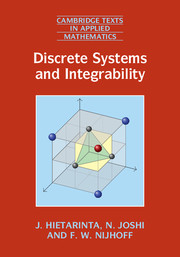Book contents
- Frontmatter
- Dedication
- Contents
- Preface
- 1 Introduction to difference equations
- 2 Discrete equations from transformations of continuous equations
- 3 Integrability of P∆Es
- 4 Interlude: Lattice equations and numerical algorithms
- 5 Continuum limits of lattice P∆E
- 6 One-dimensional lattices and maps
- 7 Identifying integrable difference equations
- 8 Hirota's bilinear method
- 9 Multi-soliton solutions and the Cauchy matrix scheme
- 10 Similarity reductions of integrable P∆Es
- 11 Discrete Painlevé equations
- 12 Lagrangian multiform theory
- Appendix A Elementary difference calculus and difference equations
- Appendix B Theta functions and elliptic functions
- Appendix C The continuous Painlevé equations and the Garnier system
- Appendix D Some determinantal identities
- References
- Index
3 - Integrability of P∆Es
Published online by Cambridge University Press: 05 September 2016
- Frontmatter
- Dedication
- Contents
- Preface
- 1 Introduction to difference equations
- 2 Discrete equations from transformations of continuous equations
- 3 Integrability of P∆Es
- 4 Interlude: Lattice equations and numerical algorithms
- 5 Continuum limits of lattice P∆E
- 6 One-dimensional lattices and maps
- 7 Identifying integrable difference equations
- 8 Hirota's bilinear method
- 9 Multi-soliton solutions and the Cauchy matrix scheme
- 10 Similarity reductions of integrable P∆Es
- 11 Discrete Painlevé equations
- 12 Lagrangian multiform theory
- Appendix A Elementary difference calculus and difference equations
- Appendix B Theta functions and elliptic functions
- Appendix C The continuous Painlevé equations and the Garnier system
- Appendix D Some determinantal identities
- References
- Index
Summary
The permutability property of Bäcklund transformations of solutions (of soliton equations), as discussed at the end of the previous chapter, forms one of the main sources of integrable partial difference equations (P∆Es) on the two-dimensional space–time lattice. In this chapter we study these equations in their own right, i.e. ignore their origin, and no longer assume that the dependent variable is a solution of any previously given PDE. In particular, we will consider the “integrability” of these P∆Es.
In general terms the concept of integrability is associated with regularity, solvability and amenability to exact and explicit treatments. These notions will have different mathematical meanings in different contexts, and it is indeed an open problem to give a universal definition of integrability. There are many characteristics associated with integrability, such as the existence of a Lax pair, compatibility structures such as Bäcklund transforms and hierarchies of compatible equations, good behavior of solutions with respect to singularities, regularity with regard to growth properties and complexity of solutions. These aspects of integrability are reflected in various different approaches in constructing and solving P∆Es, such as the τ -function approach of Hirota and the Kyoto school, symmetry methods and inverse methods such as “direct linearization”, some of which will be discussed in later chapters. Many of these features can be posed as definitions of integrability, but they are often restricted to specific classes of integrable systems. It is remarkable that if any two different definitions of integrability can be applied to some joint set of equations, they agree on which equations should be called integrable.
The presence of free parameters in the equations (namely the Bäcklund parameters λ and μ, which we will now reinterpret as lattice parameters) will play a crucial role in the development of the theory in this chapter. Furthermore, as we will see later, the parameters render the P∆Es very rich: since they can be seen to represent the widths of the underlying lattice grid they allow us to recover, through continuum limits, a great wealth of other equations, semi-continuous (i.e. differential-difference type) as well as fully continuous (i.e. partial differential type) ones. The interplay between the discrete and continuous structures will prove to be one of the emerging features of the integrable systems that we study.
- Type
- Chapter
- Information
- Discrete Systems and Integrability , pp. 67 - 118Publisher: Cambridge University PressPrint publication year: 2016

